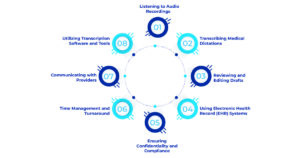The process of medical transcription requires healthcare professionals to record their medical reports through voice which transcriptionists transform into written documents. The profession demands a deep understanding of medical language together with human body structure knowledge, exceptional writing abilities, and typing speed.
Furthermore, medical transcriptionists maintain crucial patient records through their work because these records serve as essential documentation for medical diagnosis treatment and insurance claims. So, medical transcription continues to have demand despite declining because of speech recognition tools and electronic record systems. It offers specific opportunities for expert transcriptionists.
What Is Medical Transcription?
Medical transcription is the process of typing what the doctors speak. Doctors take patients’ information through spoken words. A medical transcriptionist listens to the recorded information and then takes it down. This includes check-up notes, test results, and treatments. They have to be familiar with medical terms and be able to comprehend them.
In addition, it helps doctors save time. They do not need to write all of it. The written notes are stored in the patient’s record. These records are used for treatment, insurance, or any other legal matters in the future. Thus, the work should be accurate and unambiguous. Thus, medical transcriptionists have to pay close attention and type accurately.
Medical Transcription Online Process
Medical transcription online refers to the practice of doing transcription work through the use of the internet. Physicians forward their voice messages through secure web platforms. The medical transcriptionist listens to them and types reports from home or any other place. It makes the work easier and faster for sharing with hospitals and clinics. Other features include checking spelling, grammar, and even medical terms in the text.
Likewise, it is beneficial to both the doctors and the transcriptionists to work in an online medical transcription service. Doctors get their reports quickly. Transcriptionists can work from home and do not require transportation. Hence, it allows time and money to be saved. It also assists the hospitals to maintain digital records securely. So, it makes it possible to locate patient files at any given time that the need arises.
Duties Involved in a Medical Transcription Service

1. Listening to Audio Recordings
Medical transcriptionists first start with the recorded voice messages made by doctors or other healthcare professionals. Such records may include patient histories, physical examinations, consultations, operations, or discharge notes. The transcriptionist should be able to distinguish between different accents, speech rates, background noise, and clinical settings to be able to transcribe the spoken words.
2. Transcribing Medical Dictations
The next process after listening is the writing down of what has been said in the audio. The transcriptionist writes down the spoken words in a word-by-word manner while preserving the meaning, the tone, and the medical nature of the conversation. It is important to write grammatically correct, punctuated, and formatted text to produce documents that are acceptable in healthcare documentation.
3. Reviewing and Editing Drafts
After the first draft has been produced, the transcriptionist proofreads the document in search of mistakes. They involve the verification of correct spelling and grammar, the rendering of correct punctuation, the words and meanings of the blocks, and the clinical connection appropriate to the field of medicine and health. Proofreading is important to ensure that there are no mistakes in the final report that is to be submitted.
4. Using Electronic Health Record (EHR) Systems
Medical transcriptions become part of patient electronic health records after final review. Medical transcriptionists need to master EHR system operations to properly format documents before they file them in the correct patient record with no information loss or system errors.
5. Ensuring Confidentiality and Compliance
Medical transcriptionists maintain the responsibility to handle protected patient health information. HIPAA guidelines, along with other data protection laws, require medical transcriptionists to maintain privacy throughout their work.
6. Time Management and Turnaround
Time management remains essential for every employee. Transcriptionists must meet deadlines for all document completion, especially when dealing with emergency care-related reports. Healthcare providers obtain necessary information promptly because good time management practices are in place.
7. Communicating with Providers
The recorded audio sometimes contains unclear, incomplete, or contradictory parts. When transcriptionists encounter unclear sections in the audio, they should contact the dictating healthcare provider to verify the information. Thorough communication practices protect the accuracy together with the integrity of medical records.
8. Utilizing Transcription Software and Tools
Medical transcriptionists normally use dedicated software programs together with foot pedals and headsets to enhance their transcription work. Speech recognition technology requires their assistance to edit and normalize its output for creating high-quality medical documentation.
Medical Transcription Services for Doctors
Medical Transcription Services are essential tools that assist doctors in maintaining precise and well-organized patient records. Medical transcription services transform voice-recorded medical reports into written documents, helping doctors save time and giving them more time to care for patients instead of completing paperwork.
Additionally, medical transcription specialists maintain precise documentation of clinical information through proper medical terminology and formatting standards. Medical transcription services help healthcare providers achieve improved documentation precision and workflow optimization. Medical practitioners benefit from quick results and minimized administrative work while maintaining secure EHR system connectivity.
Medical Transcription Dataset
Here is a list of key components typically found in a Medical Transcription Dataset:
- Patient demographics (name, age, gender, ID).
- Date and time of visit or procedure.
- Dictation text (verbatim transcription of physician’s notes).
- Medical specialty (e.g., cardiology, orthopedics, radiology).
- Diagnosis and medical history.
- Physical examination findings.
- Lab results and imaging findings.
- Treatment plans and prescribed medications.
- Operative reports and surgical notes
Bottom Line
To sum up, medical transcriptionists translate physician and healthcare professional voice-recorded medical reports into written documentation. The profession demands thorough medical vocabulary knowledge alongside complete medical body system education. It includes expert-level typing skills combined with star-level grammar abilities.
Moreover, accurate patient records maintained by transcriptionists serve as essential documentation for clinical diagnosis and treatment and insurance reimbursement processes. The decline in medical transcription work. It is due to the recognition technology and electronic health records have not eliminated the need for skilled transcriptionists. If you need medical billing, coding, credentialing, AR follow-up, and then front desk assistance, reach out to us at MAVA Care.
FAQs
How long does it take to become a medical transcriptionist?
The duration to become a medical transcriptionist from six months to two years based on the chosen training program. Medical transcriptionist training takes between six months and two years to finish through different educational options.
Why is medical transcription a dying field?
Medical transcription demand has decreased because healthcare providers use EHR systems and speech recognition software. Healthcare providers currently utilize automated documentation tools in their practices. The industry transformation has resulted in a reduction of available positions and decreased earning potential for medical transcriptionists.
Is medical transcription still in demand?
The overall demand reduction has not eliminated the requirement for experienced transcriptionists who specialize in specific areas. The necessity of accurate medical report transcription becomes paramount when dealing with legal or specialized medical sectors.
Is transcription still in demand?
The demand for transcription services remains high in legal fields together with academic and media industries. The medical field experienced decreased demand because of automation, yet several specialized transcription roles remain available. Transcriptionists who combine editing capabilities with specialized terminology expertise maintain their value in the industry.








